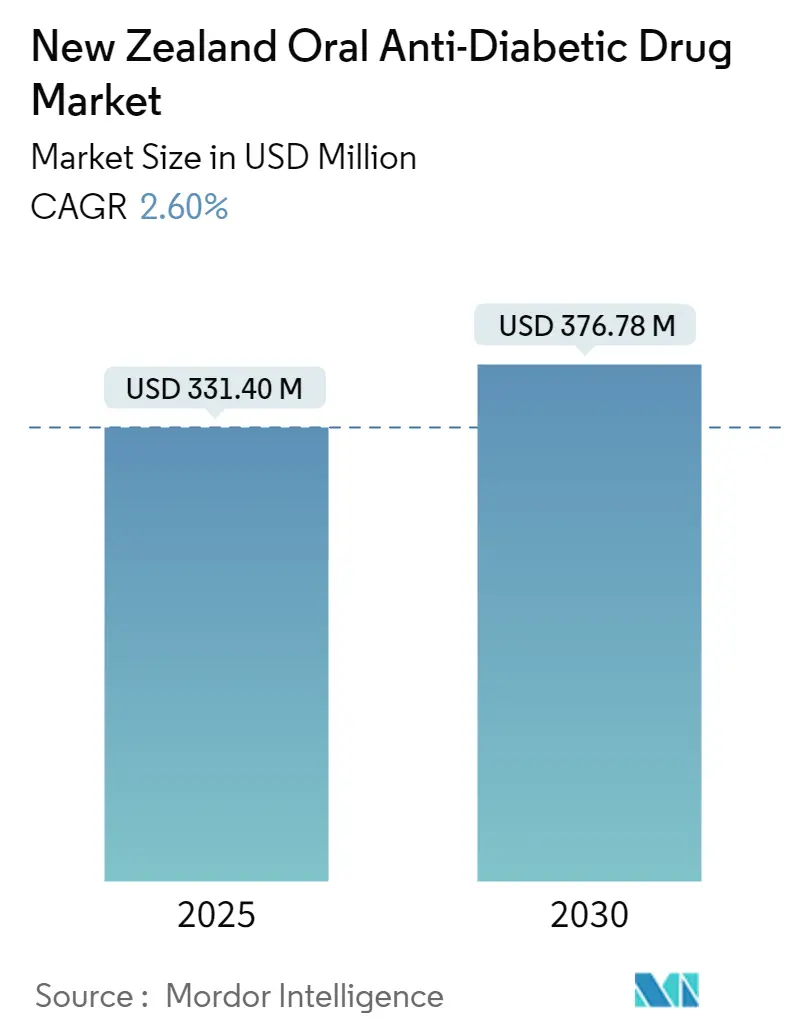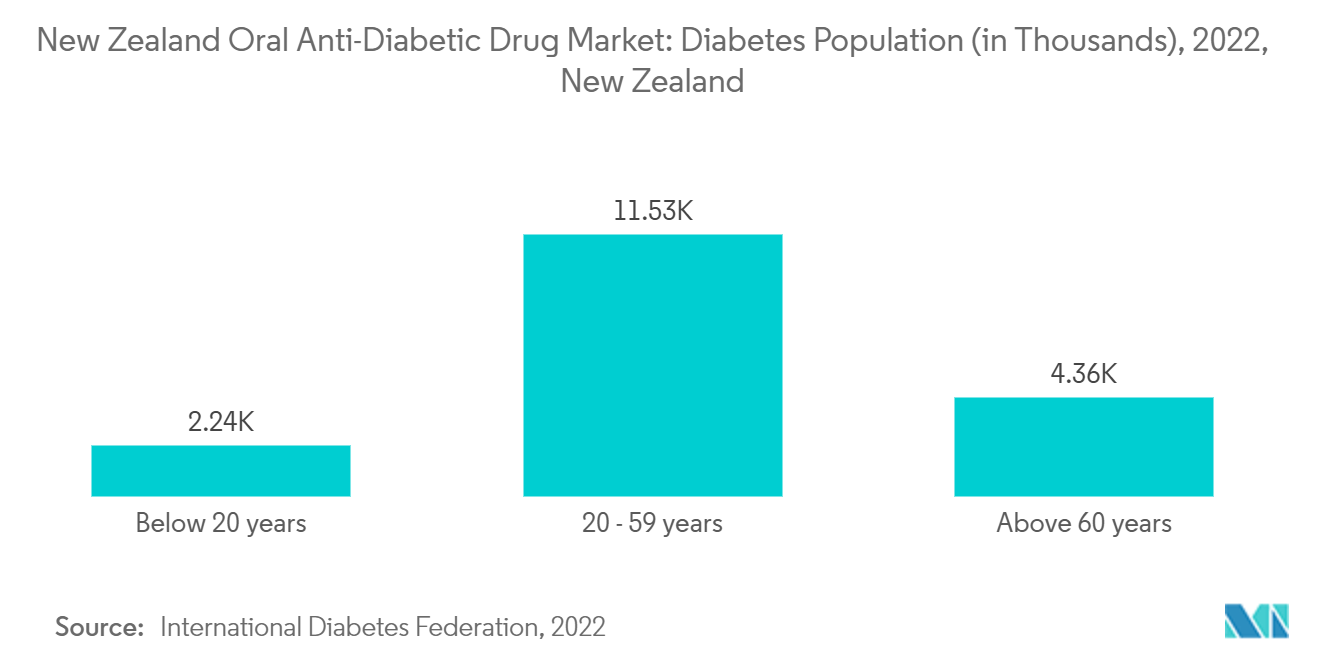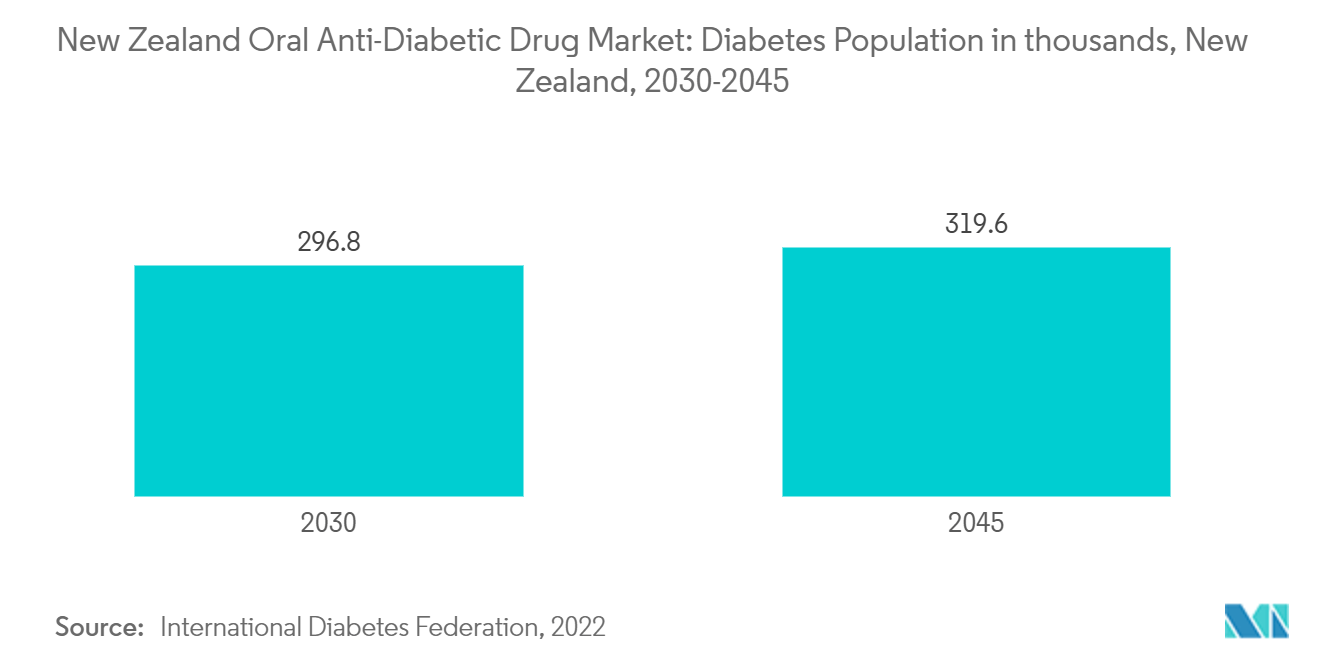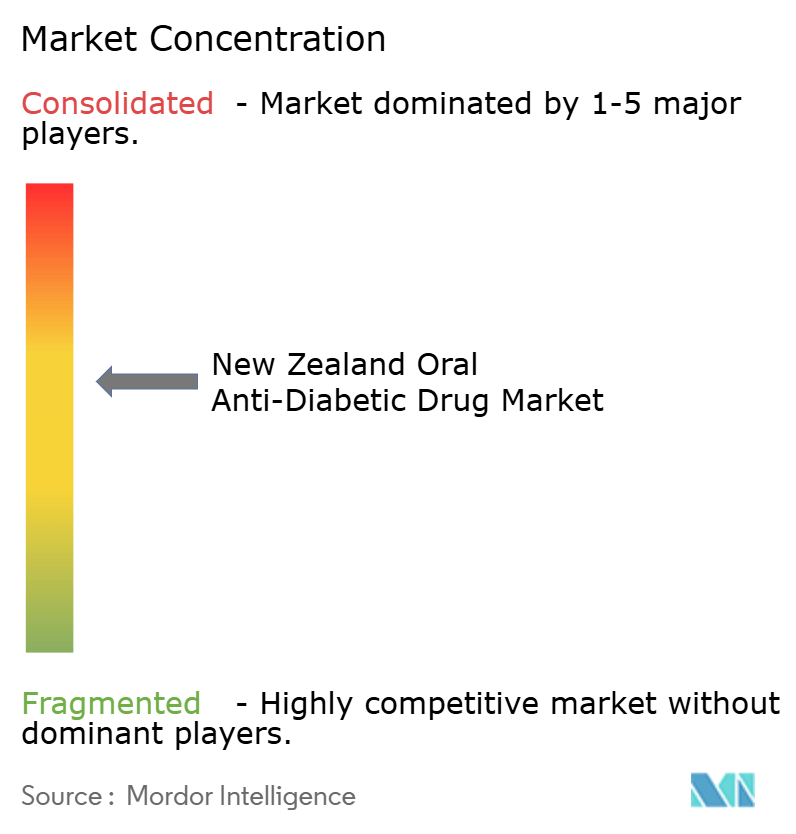New Zealand Oral Anti-Diabetic Drug Market Size and Share

New Zealand Oral Anti-Diabetic Drug Market Analysis by Mordor Intelligence
The New Zealand Oral Anti-Diabetic Drug Market size is estimated at USD 331.40 million in 2025, and is expected to reach USD 376.78 million by 2030, at a CAGR of 2.6% during the forecast period (2025-2030).
The market for oral anti-diabetic drugs in New Zealand is expected to record significant growth, propelled by the rising prevalence of diabetes and a preference for oral treatments. With diabetes posing numerous health risks, patients must monitor their blood glucose levels consistently.
The surging prevalence of diabetes in the region is indicative of the rising need for oral anti-diabetic medications. As per the International Diabetes Federation (IDF), in 2022, New Zealand reported approximately 18,000 cases of type-1 diabetes, with 2.2 thousand patients under the age of 20, 11.5 thousand aged between 20-59, and 4.4 thousand over 60. These figures underscore the urgent demand for oral anti-diabetic drugs, signaling significant market expansion.
Initiatives by non-profit organizations to bolster diabetes screening have significantly increased. For instance, in April 2024, the Diabetes NZ Auckland team intensified efforts to link mobile testing, HOPE education for diabetes prevention, and diabetes self-management programs in Auckland. With enhanced diabetes screening, the number of diagnosed individuals is likely to rise, subsequently boosting the demand for oral anti-diabetic medications.
Given the high prevalence of diabetes and the increasing shift toward oral treatments, the market for oral anti-diabetic drugs is on track for substantial growth in New Zealand. As healthcare practices advance, the demand for effective diabetes management solutions is expected to maintain this growth trajectory.
New Zealand Oral Anti-Diabetic Drug Market Trends and Insights
The Biguanide Segment Occupied a Significant Market Share in 2023
The biguanide segment experienced significant growth in 2023, driven by increased regulatory approvals and enhanced financial accessibility for affordable drugs.
Metformin, a notable biguanide, is primarily used to manage type 2 diabetes and is also prescribed off-label for conditions such as insulin resistance. Since its introduction, metformin has effectively treated a substantial number of patients. Endorsed as a first-line treatment by the IDF, it boasts a commendable risk/benefit profile.
Until May 2024, PHARMAC's funded treatment program included combinations of metformin with vildagliptin and empagliflozin. For instance, a September 2023 article by Medsafe New Zealand reported that in 2022, 57,787 individuals received metformin + vildagliptin (Galvumet) under this program, significantly enhancing drug accessibility and adoption rates. However, due to supply shortages, the program was paused for new patients.
In New Zealand, key manufacturers of metformin-based diabetes drugs include Novartis New Zealand Ltd, Boehringer Ingelheim (NZ) Ltd, and AstraZeneca Limited.
The biguanide segment, particularly metformin, plays an important role in diabetes management. Despite supply challenges, the segment's growth prospects remain strong due to ongoing regulatory support and financial initiatives to improve drug accessibility.

The Increasing Diabetes Population in New Zealand is Driving the Market
Diabetes is a global health concern, including in New Zealand. The country's diabetes rates are on the rise, prompting urgent responses from healthcare authorities and stakeholders.
Diabetes is on the upswing across all age brackets in New Zealand, a trend primarily linked to a burgeoning obese demographic, poor dietary habits, and sedentary lifestyles. Projections from the International Diabetes Federation (IDF) suggest that by 2030, New Zealand's diabetic populace will reach 296.8 thousand, climbing to 319.6 thousand by 2045. As the number of diabetic people increases, New Zealand's expenditure on diabetes-related health is also expected to increase from around USD 1,101.2 million in 2030 to an estimated USD 1,116.7 million in 2045. With diabetes prevalence on the rise and New Zealand's proactive approach, the market is expected to record substantial growth during the forecast period.
Moreover, initiatives such as free diabetes tests are likely to amplify diabetes diagnoses. For instance, Ilam Medical offers complimentary annual diabetes checks, emphasizing the importance to all diabetic patients. These checks encompass blood and urine tests, a foot circulation assessment, and comprehensive discussions on medication, diet, and exercise.
New Zealand's struggle with diabetes presents a dual narrative of challenges and opportunities. The nation's dedication to combatting this health crisis through innovative solutions and updated protocols will be pivotal in lessening its future health and economic repercussions.

Competitive Landscape
New Zealand's oral anti-diabetes drug market is consolidated, with a few major manufacturers like Eli Lilly, AstraZeneca, Sanofi, and Janssen Pharmaceuticals having a global presence. The remaining manufacturers are confined to other local or regional markets. Companies are focusing on innovations in diabetes drugs.
New Zealand Oral Anti-Diabetic Drug Industry Leaders
-
Astellas Pharma Inc.
-
AstraZeneca
-
Sanofi
-
Eli Lilly and Company
-
Janssen Pharmaceuticals
- *Disclaimer: Major Players sorted in no particular order

Recent Industry Developments
- April 2023: Pharmac provided funding for liraglutide, known by its brand name Victoza and Pharmacode 2653990, in New Zealand. Pharmac's funding of liraglutide was due to the uncertainty surrounding the availability of dulaglutide, which could be attributed to the global surge in demand for GLP-1 agonists.
- March 2023: Pharmac reported that a special authority application is required for funding empagliflozin (with or without metformin), dulaglutide, and liraglutide for treating type 2 diabetes.
New Zealand Oral Anti-Diabetic Drug Market Report Scope
Orally administered anti-diabetic drugs reduce blood glucose levels. They are often used in type 2 diabetes care.
The oral anti-diabetic drug market in New Zealand is segmented by drugs into biguanides, alpha-glucosidase inhibitors, sulphonylurea, sodium-glucose cotransport-2 (SGLT-2) inhibitors, dipeptidyl peptidase-4 (DPP-4) inhibitors, and others. The report offers the value (USD) for all the above segments.
| Biguanides |
| Alpha-Glucosidase Inhibitors |
| Sodium-Glucose Cotransport-2 (SGLT-2) Inhibitors |
| Dipeptidyl Peptidase-4 (DPP-4) Inhibitors |
| Sulfonylureas |
| Others |
| By Drug Type | Biguanides |
| Alpha-Glucosidase Inhibitors | |
| Sodium-Glucose Cotransport-2 (SGLT-2) Inhibitors | |
| Dipeptidyl Peptidase-4 (DPP-4) Inhibitors | |
| Sulfonylureas | |
| Others |
Key Questions Answered in the Report
How big is the New Zealand Oral Anti-Diabetic Drug Market?
The New Zealand Oral Anti-Diabetic Drug Market size is expected to reach USD 331.40 million in 2025 and grow at a CAGR of 2.60% to reach USD 376.78 million by 2030.
What is the current New Zealand Oral Anti-Diabetic Drug Market size?
In 2025, the New Zealand Oral Anti-Diabetic Drug Market size is expected to reach USD 331.40 million.
Who are the key players in New Zealand Oral Anti-Diabetic Drug Market?
Astellas Pharma Inc., AstraZeneca, Sanofi, Eli Lilly and Company and Janssen Pharmaceuticals are the major companies operating in the New Zealand Oral Anti-Diabetic Drug Market.
What years does this New Zealand Oral Anti-Diabetic Drug Market cover, and what was the market size in 2024?
In 2024, the New Zealand Oral Anti-Diabetic Drug Market size was estimated at USD 322.78 million. The report covers the New Zealand Oral Anti-Diabetic Drug Market historical market size for years: 2019, 2020, 2021, 2022, 2023 and 2024. The report also forecasts the New Zealand Oral Anti-Diabetic Drug Market size for years: 2025, 2026, 2027, 2028, 2029 and 2030.
Page last updated on:
New Zealand Oral Anti-Diabetic Drug Market Report
Statistics for the 2025 New Zealand Oral Anti-Diabetic Drug market share, size and revenue growth rate, created by Mordor Intelligence™ Industry Reports. New Zealand Oral Anti-Diabetic Drug analysis includes a market forecast outlook for 2025 to 2030 and historical overview. Get a sample of this industry analysis as a free report PDF download.



